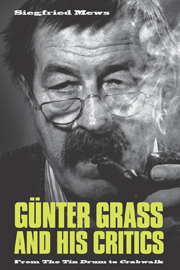Book contents
- Frontmatter
- Contents
- List of Abbreviations
- Introduction
- Part 1 Danzig, Center of the Universe
- Part 2 From Danzig to the Global Stage: Grass's Fiction of the 1970s and 1980s
- Part 3 After Reunification: Old Problems and New Beginnings
- 12 Unkenrufe / The Call of the Toad
- 13 Ein weites Feld / Too Far Afield
- 14 Mein Jahrhundert / My Century
- 15 Im Krebsgang / Crabwalk
- Epilogue
- Works Cited
- Index
14 - Mein Jahrhundert / My Century
from Part 3 - After Reunification: Old Problems and New Beginnings
Published online by Cambridge University Press: 05 February 2013
- Frontmatter
- Contents
- List of Abbreviations
- Introduction
- Part 1 Danzig, Center of the Universe
- Part 2 From Danzig to the Global Stage: Grass's Fiction of the 1970s and 1980s
- Part 3 After Reunification: Old Problems and New Beginnings
- 12 Unkenrufe / The Call of the Toad
- 13 Ein weites Feld / Too Far Afield
- 14 Mein Jahrhundert / My Century
- 15 Im Krebsgang / Crabwalk
- Epilogue
- Works Cited
- Index
Summary
A Media Event
AS HAPPENED IN THE CASE OF Ein weites Feld four years earlier, the official publication on 7 July 1999 of Mein Jahrhundert, in both a text version and an edition with watercolors, was accompanied and preceded by Grass's readings from his new work (Schade 2004 provides an account of one Grass's performances; see below), radio and TV broadcasts, interviews, exhibits, an advance publication in the weekly Die Zeit (1 July 1999), and a meeting of translators in Göttingen as early as April 1999 during which Grass sought to explain difficult passages and terms in this specifically “German” work (H. Zimmermann 1999). The Steidl publishing company's skillfully arranged book launch in general and the numerous happenings in conjunction with the publication in particular suggest a media event and shifted attention, as Ulrich Baron (1999a) asserted in the daily Die Welt, from the literary text to the “Großschriftsteller” (eminent writer) Grass himself. Since the publication of Die Blechtrommel Grass had increasingly begun to dominate the literary scene and had gained in international stature in the face of the often unenthusiastic and even hostile response to his later works on the part of the German Feuilleton. The text itself, Baron wrote in another review in the same paper (1999b), is based on the principle of stringing together beads: it features mostly unknown protagonists without regard to any overarching historical context.
- Type
- Chapter
- Information
- Günter Grass and his CriticsFrom 'The Tin Drum' to 'Crabwalk', pp. 300 - 313Publisher: Boydell & BrewerPrint publication year: 2008



